11 Common Blogging Mistakes Cost You Big Time (Fix Now!)

I thought I’d hit the jackpot. After weeks of writing, I finally published my masterpiece blog post.
I waited for the flood of comments, the viral shares, the internet fame. What do I get instead? The deafening sound of silence.
Sound familiar? If you’re nodding along, stick around. We’re about to dive into the common blogging mistakes that can turn your digital dreams into virtual tumbleweeds.
But here’s the kicker: these mistakes? They’re not just pitfalls. They’re your ticket to blogging stardom – if you know how to flip the script.
Whether you’re a blogging newbie or a seasoned wordsmith, this guide is your roadmap to avoiding the face-palm moments I’ve lived through (so you don’t have to).
Ready to launch your dream blog that doesn’t just survive, but thrives?
Here’s what you’re going to learn: Your Blogging Glow-Up Starts Here 🚀
- Discover the “oops” that’ll boost your traffic by 3x 📈
- Uncover the SEO secret weapon hiding in plain sight 🔍
- Learn why your “perfect” post might be your biggest fail 🎭
- Master the visual trick that keeps readers glued to your page 👀
- Turn your blogging “failures” into your success story 🏆
We’re about to turn your blogging mistakes into blogging success. Master the art of blogging and unlock the benefits of the blogging world that go way beyond just stringing words together.
Time to flip the script on your blogging game. You in?
1. Neglecting a Content Strategy

I didn’t have a content strategy when I started blogging. That might be the reason why I struggled most of the time blogging.
So, have a solid and flexible content strategy. Without it, is like a ship without a destination and you will drift aimlessly from post to post. Trust me, it’s not a fun place to be.
Did you know that 65% of the most successful content marketers have a documented content strategy? (Source: Content Marketing Institute)
A solid content strategy is not only about churning out posts. It’s about creating content that resonates with your audience and aligns with your goals.
Whether you’re aiming to educate, entertain, or sell, your strategy keeps you on track.
So, how do you create an effective content strategy? Start by defining your blog’s purpose and target audience.
Then, outline your content pillars – the main topics you’ll cover. For example, my niche is digital marketing, I even niched down to individual sub-niches within my main niche.
The individual sub-niches might be blogging, SEO, content marketing, etc.
I focused on one sub-niche at a time to become a go-to expert in that sub-niche. And then, I expanded to other sub-niches within digital marketing.
I followed the same method for social media as well. This strategic approach enabled me to cover topics individually without getting lost in the vast ‘digital marketing’ niche.
Next, set clear, measurable goals. Maybe you want to increase traffic by 20% in three months or gain 100 email subscribers.
Whatever your aims, make them SMART: Specific, Measurable, Achievable, Relevant, and Time-bound.
Remember, your strategy isn’t set in stone. As you grow, you’ll learn what works best for your audience.
Be ready to pivot and refine your approach.
Curious about how to come up with fresh content ideas that keep your readers coming back for more? Let’s dive into that next.
2. Inconsistent Posting Schedule

Imagine your favorite TV show aired episodes randomly without warning. Frustrating, right?
That’s how readers feel when your blog posting schedule is all over the place. I was all over the place in the beginning stages because of my perfectionist mindset.
It hit me hard, then over time getting experience in blogging, I learned the ‘good enough, move on’ mindset.
Because I can update the blog posts at any time I want. This mindset gave me the power to hit the publish button.
Consistency is key in blogging. It keeps your readers engaged and builds trust and anticipation.
When you post regularly, your audience knows when to expect new content, and they’re more likely to come back for more.
So, how do you stay consistent? Create an ideal blog content calendar. It doesn’t have to be fancy – I started with a simple Google Sheet.
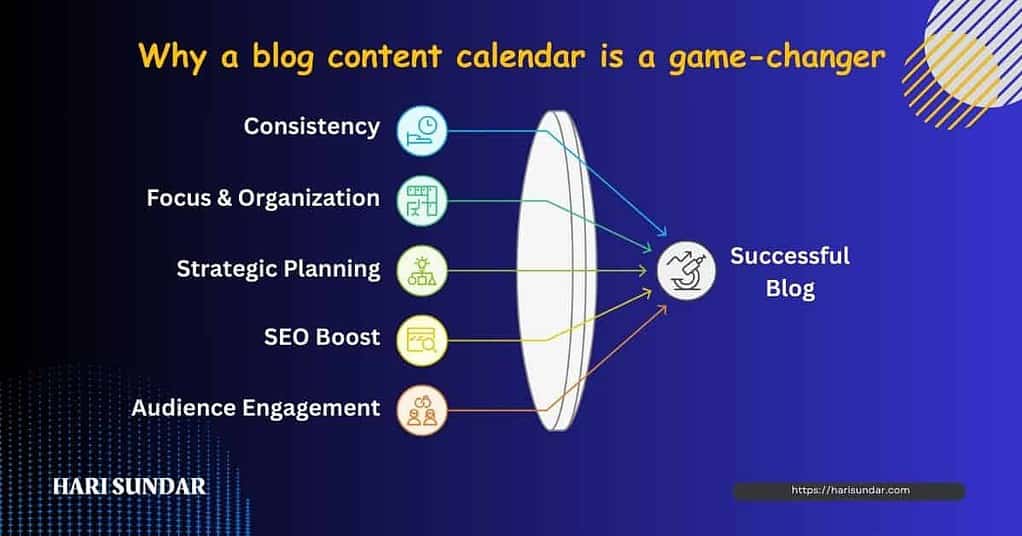
Plan your topics, assign publish dates, and stick to them. If you’re struggling with ideas, brainstorm a list of potential posts and slot them into your calendar.
But here’s the tricky part: balancing quality and consistency. It’s tempting to pump out content just to meet a schedule, but that’s a recipe for mediocre posts.
Instead, find a posting frequency that works for you. Maybe it’s once a week, maybe it’s thrice a month.
Whatever you choose, make sure you can maintain it without sacrificing quality.
Also, having a blogging checklist handy will speed up your publishing frequency. I won’t publish until I tick all the boxes in the checklist.
Pro tip: Batch your content creation. Set aside a day to write multiple posts at once. This way, you’ll always have a backlog of content ready to go, even on busy weeks.
Keep in mind, that consistency builds momentum. It’s a snowball effect, the more you stick to your schedule, the easier it becomes.
But what happens when you’ve got your posting schedule down pat, but your content still isn’t resonating with readers? Let’s tackle that next.
3. Ignoring SEO Fundamentals

Around 75% of users never scroll past the first page of search results. I thought content alone would bring readers to my site. That’s all I knew when I started!
If you look at my old blog, you will notice that I hadn’t implemented any SEO. Because I didn’t know SEO, the results? I got less organic traffic from Google.
So, without SEO, your brilliant posts might as well be invisible.
SEO isn’t rocket science, but it does require some know-how. At its core, it’s about making your content easily discoverable by search engines.
Start with keyword research – find out what your audience is searching for. And incorporate those terms naturally into your posts.
But don’t go overboard – keyword stuffing is so last decade.
Use descriptive titles and meta descriptions, structure your content with headers (H1, H2, etc.), and include alt text for images.
One mistake I made early on was neglecting internal linking – don’t forget to connect your posts!
Tools can be a huge help in your SEO journey. Google Search Console is a must for understanding how search engines see your site.
For keyword research, try Google Keyword Planner or Ahrefs (paid). Google Analytics can give you valuable insights into your audience and traffic sources.
Remember, SEO for new bloggers doesn’t have to be intimidating. Start with the basics and build from there. It’s an ongoing process, but the payoff in visibility is worth it.
Now that we’ve covered SEO, let’s talk about another crucial aspect of blogging success. How do you keep your readers coming back for more? The answer might surprise you.
4. Producing Shallow Content
Quality trumps quantity in blogging. I learned this the hard way when my early posts barely skimming the surface of topics, got ignored.
It turns out, that readers leave if your posts contain more fluff than flavor.
A study by Backlinko shows that long-form content (3000+ words) gets an average of 77.2% more backlinks than shorter content.
Shallow content is like eating fast food – it might satisfy momentarily, but it leaves readers hungry for more.
It doesn’t solve problems or provide real value. Plus, search engines aren’t fans either. Google’s algorithms favor in-depth, comprehensive content that truly answers user queries.
So, how do you create meaty, valuable posts?
Start by diving deep into your topic. Research thoroughly, include data and examples, and offer unique insights.
When I wrote a guide on SEO for beginners, I didn’t just list tips – I explained the why behind each strategy and included step-by-step instructions.
But the tricky part is balancing depth with readability. No one wants to wade through a wall of text.
Break up your content with subheadings, bullet points, and images. Use simple language and short paragraphs. Think of it as serving a gourmet meal in bite-sized portions.
Remember, creating in-depth content takes time. But it’s worth it. These posts become evergreen resources that keep bringing in traffic long after publication.
Now that we’ve beefed up our content, let’s tackle another common pitfall. How do you make sure your blog doesn’t look like it’s stuck in the 90s?
5. Overlooking Your Target Audience

Who are you writing for? If you answer “everyone,” you’re setting yourself up for failure. I made this mistake when I started, writing about everything under the sun.
I covered one topic, nutrition, and another, history. The result? my blog remained unseen.
Turns out, when you try to appeal to everyone, you end up appealing to no one.
Knowing your audience is a crucial step in blogging. It helps you create content that resonates, solving real problems and answering burning questions.
So, how do you figure out who your ideal readers are?
Start with data. Use Google Analytics to learn about your current readers’ demographics and interests.
Social media insights can be gold mines too.
But don’t stop there. Engage with your audience directly. Ask questions in your posts, run surveys, and share valuable insights with them.
Once you know who you’re talking to, tailor your content accordingly. If your audience is busy professionals, break down complex topics into digestible chunks.
Are they beginners in your field? Explain concepts thoroughly without assuming prior knowledge. I love explaining concepts in a simple format.
Remember, your audience’s needs evolve. Keep tabs on comments, emails, and social media interactions. Use this feedback to refine your content strategy.
By truly understanding your audience, you’re not just creating content – you’re building a community.
Speaking of which, how do you keep that community visually engaged? Let’s talk about that next.
6. Underestimating the Power of Visuals
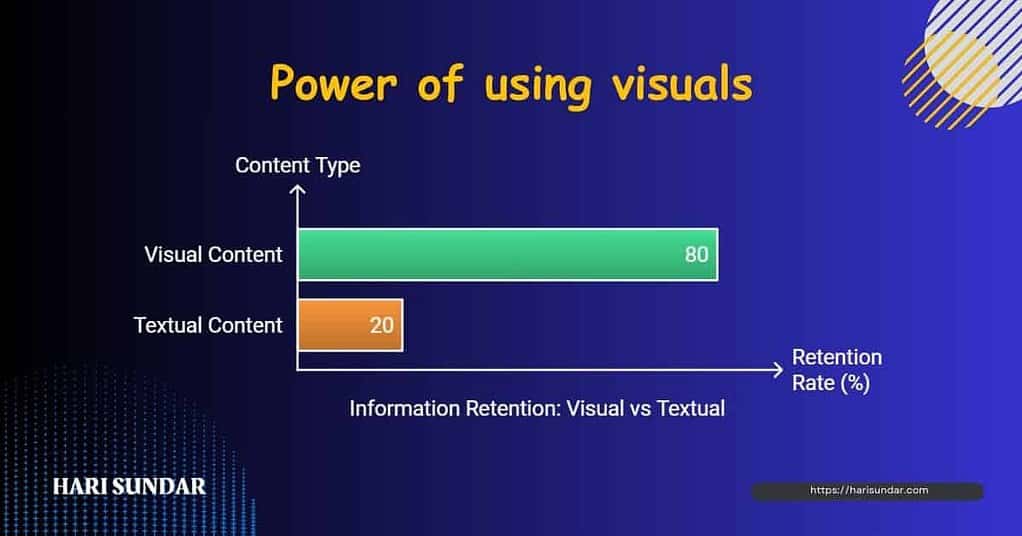
We knew that a picture is worth a thousand words, right? Well, in blogging, it might be worth even more.
Did you know that articles with images get 94% more views than those without? When I started adding relevant visuals to my posts, I saw my engagement rates increase.
Visuals aren’t just pretty decorations. They break up the text, making your content more scannable.
They can explain complex concepts at a glance. Infographics, for instance, can pack a ton of
information into an easily digestible format.
But not all visuals are created equal. Poor-quality images can hurt more than help. Aim for high-resolution, relevant images that add value to your content.
For my guide-related posts, I often use screenshots to illustrate steps in a process.
Videos are powerful too. They can demonstrate techniques, add a personal touch, or simply provide a change of pace.
Even a short, 2-minute explainer video can boost understanding and engagement.
Don’t have design skills? No worries. Tools like Canva or Piktochart make creating infographics a breeze.
For stock photos, try free resources like Unsplash or Pexels. Just remember to credit the creators when required.
The key is to use visuals strategically. Don’t add them just for the sake of it. Each visual should serve a purpose, whether it’s to illustrate a point, break up text, or evoke an emotion.
Now that we’ve made our content visually appealing, let’s tackle another crucial aspect. How do you make sure your hard work reaches your audience?
7. Neglecting Content Promotion
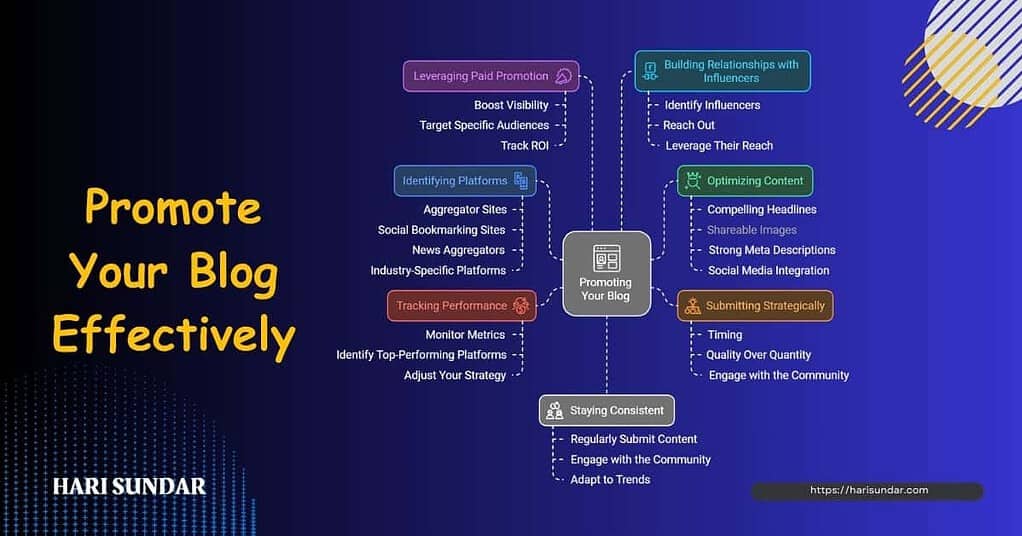
“If you build it, they will come” might work for baseball fields in movies, but it’s a recipe for disappointment in blogging.
My early posts sat unread and fell into the cracks on the internet. Then I learned, that great content is only half the battle – you’ve got to get it in front of people too.
Promoting your blog isn’t just an afterthought; it’s a crucial part of blog growth. Successful bloggers often follow the 80/20 rule: 20% creating content, 80% promoting it.
So, how do you get your content out there? Start with social media. Share your posts on platforms where your audience hangs out.
But don’t just drop links – add value. Pull out interesting snippets or ask thought-provoking questions to encourage engagement.
Email marketing is another powerful tool. Build a subscriber list and send out regular newsletters featuring your latest content.
Don’t forget about other bloggers and influencers in your niche. Comment on their posts, share their content, and reach out for collaboration opportunities.
Promotion isn’t a one-and-done deal. Keep sharing older posts that are still relevant. You never know who might have missed them the first time around.
Now that we’ve got people reading our blog, how do we turn those readers into a loyal, engaged community? That’s what we’ll explore next.
8. Failing to Build an Email List
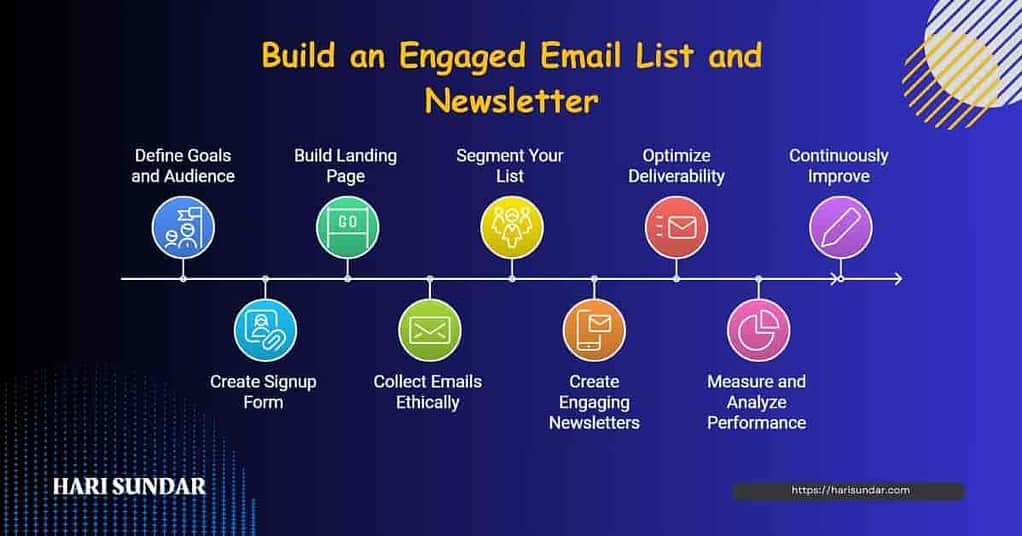
Think email is old news? Think again. Email marketing still boasts an average ROI of $42 for every $1 spent. (Source)
When I first started blogging, I ignored email lists, focusing solely on social media. Big mistake. Now I started building my email lists.
Email lists are your direct line to readers. Unlike social media, where algorithms decide who sees your content, emails land right in your subscribers’ inboxes.
Plus, email subscribers are more likely to become loyal fans and even customers down the line.
So, how do you get people to sign up?
Offer something valuable in exchange for their email. Your offer could be an ebook, a mini-course, or exclusive content – anything your audience finds useful.
Growing your list takes time. Place sign-up forms strategically on your site – in the sidebar, at the end of posts, or as a pop-up (just don’t be too pushy).
And don’t forget to nurture your list. Send regular, value-packed emails. I aim for weekly emails with tips, behind-the-scenes info, and first dibs on new content.
Remember, quality beats quantity. A small, engaged list is far more valuable than a large, unresponsive one.
Now that we’ve got our email game strong, let’s talk about another crucial aspect of blogging success.
Is your blog design helping or hurting your efforts?
9. Poor Website Design and User Experience
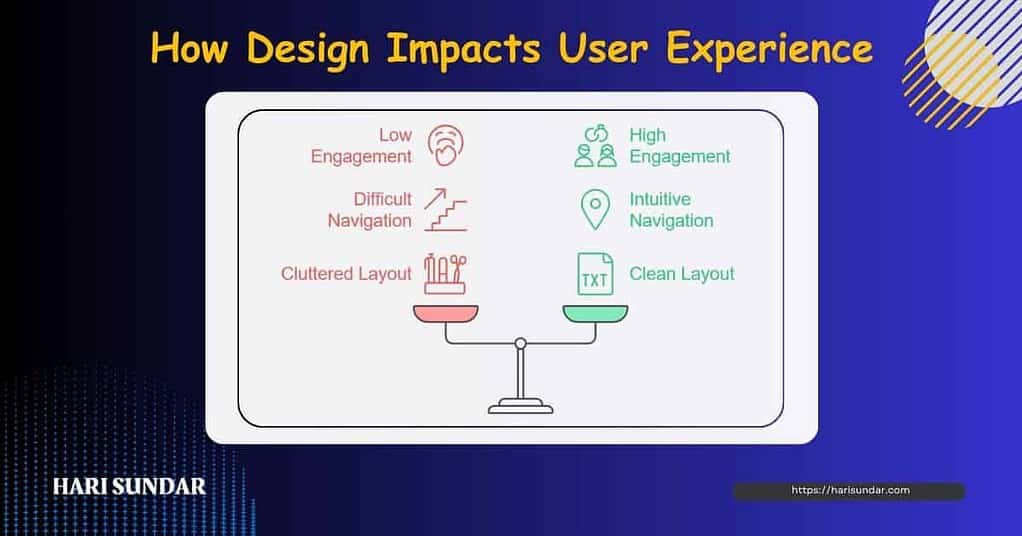
First impressions matter, especially online. Did you know that 38% of people will stop engaging with a website if the content or layout is unattractive? (HubSpot)
When I first started, my blog looked like it was stuck in the 90s. No surprise, my bounce rate was through the roof.
Your blog design should create a seamless experience for your readers. A well-designed site keeps visitors engaged.
It encourages them to explore more content and helps build trust in your brand.
Common UX mistakes can be real reader repellents. Slow loading times, cluttered layouts, hard-to-read fonts – these are all fast tracks to the ‘back’ button.
So, how do you fix these issues?
Start with the basics. Ensure your site loads quickly (aim for under 3 seconds), use a clean, easy-to-navigate layout, and choose readable fonts.
Mobile optimization is crucial too – over 50% of web traffic comes from mobile devices.
Don’t worry if you’re not a design whiz. There are plenty of tools to help. WordPress themes like Kadence or Astra offer great starting points.
For more customization, page builders like Elementor can be lifesavers.
Remember, good design is invisible. It should enhance your content, not overshadow it.
We’ve covered design, but what about the actual writing process? How do you consistently produce quality content without burning out? Let’s dive into that next.
10. Ignoring Analytics and Data

Numbers don’t lie, but they sure can tell a powerful story. I was flying blind, relying on gut feelings and guesswork without analyzing what works and what’s not.
Once I started diving into my analytics, I discovered that my most popular post wasn’t what I thought it was. Talk about an eye-opener!
Tracking your blog’s performance isn’t just about stroking your ego with page view counts.
It’s about understanding what works, what doesn’t, and where to focus your efforts. Think of it as a roadmap for your blogging journey.
So, what should you be looking at? Start with the fundamentals: page views, unique visitors, and bounce rate.
These give you a snapshot of your traffic.
Also, dig deeper into metrics like time on page and popular content. These insights can shape your content strategy.
For instance, I noticed my how-to posts kept readers engaged longer, so I created more of them.
Google Analytics is your best friend here. It’s free and packed with features. Set up goals to track specific actions, like newsletter sign-ups or product purchases.
Use the Behavior Flow report to see how visitors navigate your site. This can help you optimize your layout and internal linking.
Remember, data without action is just noise. Use your insights to inform your decisions.
If a particular topic is resonating, consider creating a series around it. If social media isn’t driving traffic, maybe it’s time to try a new platform.
But what if the numbers aren’t what you hoped for? That’s where persistence comes in. Let’s talk about that next.
11. Giving Up Too Soon
Rome wasn’t built in a day, and neither is a successful blog!
Did you know it takes an average of 6 months to a year for a new blog to gain traction? Don’t expect overnight success (but I expected it with my old blog!).
Months in, with barely any traffic, I was ready to throw in the towel. I abandoned blogging for over a year. Then I learned everything from scratch and started this blog.
Blogging is a marathon, not a sprint. It takes time to build an audience, establish authority, and get those search engine rankings.
The key is to set realistic expectations and stay motivated during the slow periods.
So how do you keep going when it feels like you’re shouting into the void? Start by setting small, achievable goals.
Maybe it’s publishing consistently for a month or getting your first comment from a non-family member.
Celebrate these wins – they’re stepping stones to bigger success. Track your progress over time, not day-to-day. I keep a spreadsheet of my monthly stats.
Seeing that gradual upward trend, even if it’s slow, keeps me motivated.
And don’t just focus on numbers. Appreciate the skills you’re developing and the knowledge you’re gaining.
Remember, every successful blogger started where you are. They just didn’t quit. Overcoming blogging challenges is part of the journey. Embrace them as learning opportunities.
Feeling overwhelmed by all these potential pitfalls? Don’t worry. With the right mindset and strategies, you can navigate them successfully.
Conclusion
Wait, you mean I should celebrate my blogging mistakes?
Absolutely. Because the truth is, that those blunders you’ve been beating yourself up about? They’re your secret sauce.
Every “failed” post, every crickets-chirping, and every facepalm moment – they’re not just learning experiences.
They’re the building blocks of your unique blogging voice. The voice that’s going to cut through the noise and make your readers sit up and take notice.
So, here’s your challenge: pick your biggest blogging “oops” moment. The one that makes you cringe just thinking about it. Now, how can you flip it into your next big win?
Maybe your SEO neglect becomes your motivation to master keyword research. Perhaps your design disaster inspires a site overhaul that blows your readers’ minds.
Or your “boring” content could be the push you need to inject your posts with personality.
Keep in mind, that every successful blogger started somewhere – usually with a whole lot of “what was I thinking?” moments. The difference? They used those moments as fuel.
Your blog is your connection to a world of like-minded individuals. So go ahead, make mistakes. Make them boldly. Then use them to create something amazing.
Ready to turn your blogging bloopers into your success story? Your keyboard is waiting. What will you create today?
FAQs On Common Blogging Mistakes
How long does it take to see results from blogging?
It varies, but typically 6-12 months. Focus on consistent, quality content and SEO. My first old blog took around eight months to gain traction. Don’t get discouraged; keep learning and adjusting your strategy.
What’s the biggest mistake new bloggers make?
Neglecting SEO. I did this and my early posts got zero traffic. Learn keyword research, optimize your content, and build quality backlinks. It’s not just about writing; it’s about being found.
How often should I post on my blog?
Quality trumps quantity. I post 1-2 times a week, focusing on in-depth content. Find a schedule you can maintain consistently without sacrificing content quality.
Is it too late to start a blog in 2024?
Absolutely not! The key is finding your unique angle. There’s always room for fresh perspectives and quality content.
How do I monetize my blog?
Start with affiliate marketing and ads once you have traffic. As you grow, explore sponsored posts, digital products, or courses. Diversify your income streams gradually.
What’s the best way to grow my email list?
Offer a valuable lead magnet. Place opt-in forms strategically on your site and create content upgrades for popular posts.





